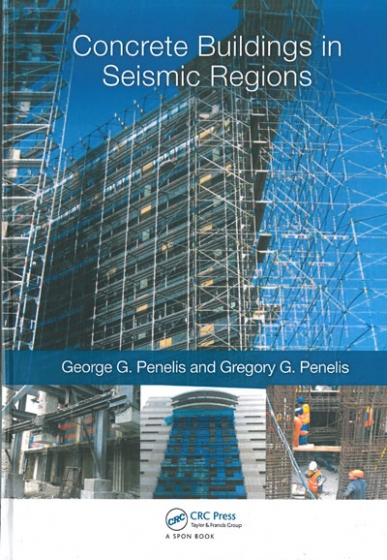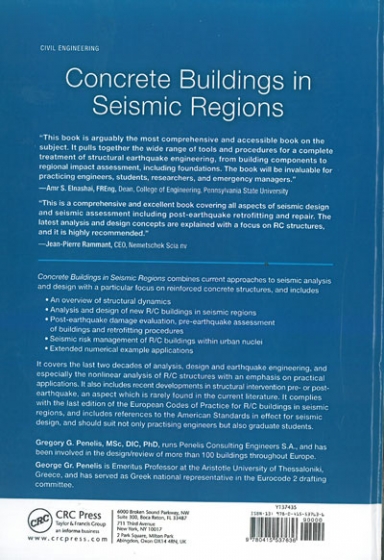Preface
This book is addressed primarily to postgraduate students in earthquake engineering and to
practising structural engineers specialising in the design of R/C seismic-resistant buildings.
The following basic aims have guided the composition of the material of this book:
1. The presentation of the content should be characterised by integrity, clarity and simplicity,
particularly for the design procedure of new R/C buildings or assessment and
retrofitting of existing ones. In this respect it should constitute integrated knowledge
for a student. The long experience of the first of the authors in teaching undergraduate
and postgraduate students about R/C earthquake-resistant structures augurs well for
the achievement of this aim.
2. The presentation of the scientific background of each subject should be made in a
concise form with all the necessary—but at the same time, limited—references to the
sources so that enough of an open field is available for a rigorous and systematic
approach to the implementation of the scientific background in design procedure. In
this context, this book would be valuable for practising engineers who want to have
in-depth knowledge of the background on which the code rules are based. The extensive
experience of both authors in the seismic design of new R/C buildings and in the
assessment and retrofitting of existing ones, together with the wide experience of the
first in posts of responsibility in seismic risk management in Greece, contribute to a
balanced merging of the scientific background with practical design issues. At the
same time, the numerical examples that are interspersed in the various chapters also
intend to serve this aim.
3. For furtherance of the above aims, all of the material of the book has been adjusted to
fit a modern Seismic Code of broad application, namely, EN1998/2004-5 (EC8/2004-
5), so that quantitative values useful for the practice are presented. At the same time,
comparative references are made to the American Standards in effect for seismic
design. It is obvious that this choice covers the design requirements for Europe. At
the same time, the comparative references to the American Standards enable an easy
adjustment of the content to the American framework of codes.
In closing, we express our thanks to the following collaborators for their contributions to
the preparation of this book.
• Professor Andreas Kappos, co-author with G. Penelis of the book titled, Earthquake
Resistant Concrete Structures (1997). We are grateful for his consent to reproduce a
number of illustrations and some parts of the text from the abovementioned book.
• Dr. Georgia Thermou, lecturer in engineering at AUTH and John Papargyriou MSc-
DIC for their contributions in the elaboration of the numerical examples.
• Dr. Phil Holland for correction and improvement of the language of the text.
• Panayiotis Savas for the elaboration of the figures.
• Evaggelia Dara for the typewritten preparation of the text.
• Dr. Kostas Paschalidis for the critical reading and correction of the text.
• Tony Moore, senior editor of Spon Press for his efforts in coordinating the publication
of the book.
George Gr. Penelis
Gregory G. Penelis
Contents
Preface xxv
Abbreviations xxvii
1 Introduction 1
1.1 Historical notes 1
1.2 Structure of this book 4
2 An overview of structural dynamics 5
2.1 General 5
2.2 Dynamic analysis of elastic single-degree-of-freedom systems 6
2.2.1 Equations of motion 6
2.2.2 Free vibration 7
2.2.3 Forced vibration 10
2.2.4 Elastic response spectra 13
2.2.4.1 Definition: Generation 13
2.2.4.2 Acceleration response spectra 16
2.2.4.3 Displacement response spectra 19
2.2.4.4 Velocity response spectra 20
2.2.4.5 Acceleration-displacement response spectra 21
2.3 Dynamic analysis of inelastic SDOF systems 22
2.3.1 Introduction 22
2.3.2 Viscous damping 22
2.3.3 Hysteretic damping 25
2.3.4 Energy dissipation and ductility 27
2.3.5 Physical meaning of the ability for energy absorption (damping) 32
2.3.6 Inelastic response spectra 35
2.3.6.1 Inelastic acceleration response spectra 35
2.3.6.2 Inelastic displacement response spectra 36
2.4 Dynamic analysis of MDOF elastic systems 37
2.4.1 Introduction 37
2.4.2 Equations of motion of plane systems 37
2.4.3 Modal response spectrum analysis versus time–history analysis 41
2.4.3.1 General 41
2.4.3.2 Modal response spectrum analysis 42
2.4.3.3 Time-history analysis 45
2.4.4 Pseudospatial structural single-storey system 46
2.4.4.1 General 46
2.4.4.2 Static response of the single-storey 3D system 48
2.4.4.3 Dynamic response of a single-storey 3D system 54
2.4.4.4 Concluding remarks 58
2.5 Dynamic analysis of MDOF inelastic systems 62
2.5.1 Introduction 62
2.5.2 Methodology for inelastic dynamic analysis of MDOF plane systems 63
2.5.3 Concluding remarks 69
2.6 Application example 70
2.6.1 Building description 71
2.6.2 Design specifications 71
2.6.3 Modelling assumptions 72
2.6.4 Static response 72
2.6.5 Hand calculation for the centre of stiffness 72
2.6.6 Mass calculation 73
2.6.7 Base shear calculation 73
2.6.8 Computer-aided calculation for the centre of stiffness 76
2.6.9 Dynamic response 79
2.6.10 Estimation of poles of rotation for building B 79
3 Design principles, seismic actions, performance requirements, compliance criteria 83
3.1 Introduction 83
3.2 Conceptual framework of seismic design: Energy balance 84
3.2.1 General 84
3.2.2 Displacement-based design 88
3.2.2.1 Inelastic dynamic analysis and design 88
3.2.2.2 Inelastic static analysis and design 88
3.2.3 Force-based design 90
3.2.4 Concluding remarks 92
3.3 Earthquake input 93
3.3.1 Definitions 93
3.3.2 Seismicity and seismic hazard 98
3.3.2.1 Seismicity 99
3.3.2.2 Seismic hazard 100
3.3.3 Concluding remarks 102
3.4 Ground conditions and design seismic actions 103
3.4.1 General 103
3.4.2 Ground conditions 105
3.4.2.1 Introduction 105
3.4.2.2 Identification of ground types 105
3.4.3 Seismic action in the form of response spectra 105
3.4.3.1 Seismic zones 105
3.4.3.2 Importance factor 106
3.4.3.3 Basic representation of seismic action in the form of a response spectrum 108
3.4.3.4 Horizontal elastic response spectrum 109
3.4.3.5 Vertical elastic response spectrum 111
3.4.3.6 Elastic displacement response spectrum 112
3.4.3.7 Design spectrum for elastic analysis 113
3.4.4 Alternative representation of the seismic action 115
3.4.4.1 General 115
3.4.4.2 Artificial accelerograms 115
3.4.4.3 Recorded or simulated accelerograms 116
3.4.5 Combination of seismic action with other actions 117
3.5 Performance requirements and compliance criteria 118
3.5.1 Introduction 118
3.5.2 Performance requirements according to EC 8-1/2004 120
3.5.3 Compliance criteria 122
3.5.3.1 General 122
3.5.3.2 Ultimate limit state 122
3.5.3.3 Damage limitation state 124
3.5.3.4 Specific measures 124
4 Configuration of earthquake-resistant R/C structural systems: Structural behaviour 125
4.1 General 125
4.2 Basic principles of conceptual design 126
4.2.1 Structural simplicity 126
4.2.2 Structural regularity in plan and elevation 126
4.2.3 Form of structural walls 127
4.2.4 Structural redundancy 129
4.2.5 Avoidance of short columns 129
4.2.6 Avoidance of using flat slab frames as main structural systems 130
4.2.7 Avoidance of a soft storey 131
4.2.8 Diaphragmatic behaviour 131
4.2.9 Bi-directional resistance and stiffness 131
4.2.10 Strong columns–weak beams 132
4.2.11 Provision of a second line of defense 132
4.2.12 Adequate foundation system 134
4.3 Primary and secondary seismic members 136
4.4 Structural R/C types covered by seismic codes 137
4.5 Response of structural systems to lateral loading 139
4.5.1 General 139
4.5.2 Plane structural systems 139
4.5.2.1 Moment-resisting frames 140
4.5.2.2 Wall systems or flexural systems 141
4.5.2.3 Coupled shear walls 142
4.5.2.4 Dual systems 143
4.5.3 Pseudospatial multistorey structural system 144
4.6 Structural configuration of multi-storey R/C buildings 150
4.6.1 General 150
4.6.2 Historical overview of the development of R/C multi-storey buildings 152
4.6.3 Structural system and its main characteristics 156
4.6.3.1 General 156
4.6.3.2 Buildings with moment-resisting frames 156
4.6.3.3 Buildings with wall systems 157
4.6.3.4 Buildings with dual systems 160
4.6.3.5 Buildings with flat slab frames, shear walls and moment-resisting frames 161
4.6.3.6 Buildings with tube systems 162
5 Analysis of the structural system 163
5.1 General 163
5.2 Structural regularity 163
5.2.1 Introduction 163
5.2.2 Criteria for regularity in plan 164
5.2.3 Criteria for regularity in elevation 166
5.2.4 Conclusions 166
5.3 Torsional flexibility 167
5.4 Ductility classes and behaviour factors 170
5.4.1 General 170
5.4.2 Ductility classes 171
5.4.3 Behaviour factors for horizontal seismic actions 172
5.4.4 Quantitative relations between the Q-factor and ductility 176
5.4.4.1 General 176
5.4.4.2 M–φ relation for R/C members under plain bending 177
5.4.4.3 Moment–curvature–displacement diagrams of R/C cantilever beams 180
5.4.4.4 Moment–curvature–displacement diagrams of R/C frames 182
5.4.4.5 Conclusions 183
5.4.5 Critical regions 185
5.5 Analysis methods 187
5.5.1 Available methods of analysis for R/C buildings 187
5.6 Elastic analysis methods 190
5.6.1 General 190
5.6.2 Modelling of buildings for elastic analysis and BIM concepts 190
5.6.3 Specific modelling issues 191
5.6.3.1 Walls and cores modelling 192
5.6.3.2 T- and Γ-shaped beams 192
5.6.3.3 Diaphragm constraint 193
5.6.3.4 Eccentricity 194
5.6.3.5 Stiffness 195
5.6.4 Lateral force method of analysis 195
5.6.4.1 Base shear forces 196
5.6.4.2 Distribution along the height 196
5.6.4.3 Estimation of the fundamental period 197
5.6.4.4 Torsional effects 198
5.6.5 Modal response spectrum analysis 199
5.6.5.1 Modal participation 200
5.6.5.2 Storey and wall shears 200
5.6.5.3 Ritz vector analysis 201
5.6.6 Time–history elastic analysis 201
5.7 Inelastic analysis methods 201
5.7.1 General 201
5.7.2 Modelling in nonlinear analysis 202
5.7.2.1 Slab modelling and transfer of loads 202
5.7.2.2 Diaphragm constraint 203
5.7.2.3 R/C walls and cores 203
5.7.2.4 Foundation 205
5.7.2.5 Point hinge versus fibre modelling 205
5.7.2.6 Safety factors 207
5.7.3 Pushover analysis 209
5.7.4 Pros and cons of pushover analysis 210
5.7.5 Equivalent SDOF systems 212
5.7.5.1 Equivalent SDOF for torsionally restrained buildings 212
5.7.5.2 Equivalent SDOF for torsionally unrestrained buildings 216
5.7.6 Time–history nonlinear analysis 224
5.7.6.1 Input motion-scaling of accelerograms 224
5.7.6.2 Incremental dynamic analysis IDA 226
5.8 Combination of the components of gravity loads and seismic action 229
5.8.1 General 229
5.8.2 Theoretical background 232
5.8.3 Simplified procedures 234
5.8.3.1 Combination of the extreme values of the interacting load effects 235
5.8.3.2 Combination of each extreme load effect with the corresponding values of the interacting ones 235
5.8.3.3 Gupta–Singh procedure 236
5.8.3.4 Rosenblueth and Contreras procedure 237
5.8.3.5 Extreme stress procedure 238
5.8.4 Code provisions 239
5.8.4.1 Suggested procedure for the analysis 239
5.8.4.2 Implementation of the reference method in case of horizontal seismic actions 240
5.8.4.3 Implementation of the alternative method in the case of horizontal seismic actions 241
5.8.4.4 Implementation of the alternative method for horizontal and vertical seismic action 245
5.9 Example: Modelling and elastic analysis of an eight-storey RC building 245
5.9.1 Building description 245
5.9.2 Material properties 247
5.9.3 Design specifications 247
5.9.4 Definition of the design spectrum 247
5.9.4.1 Elastic response spectrum (5% damping) 247
5.9.4.2 Design response spectrum 247
5.9.5 Estimation of mass and mass moment of inertia 248
5.9.6 Structural regularity in plan and elevation 248
5.9.6.1 Criteria for regularity in plan 248
5.9.6.2 Criteria for regularity in elevation 250
5.9.7 Determination of the behaviour factor q (Subsection 5.4.3) 251
5.9.8 Description of the structural model 252
5.9.9 Modal response spectrum analysis 254
5.9.9.1 Accidental torsional effects 254
5.9.9.2 Periods, effective masses and modes of vibration 255
5.9.9.3 Shear forces per storey 255
5.9.9.4 Displacements of the centres of masses 255
5.9.9.5 Damage limitations 256
5.9.9.6 Second-order effects 258
5.9.9.7 Internal forces 259
5.10 Examples: Applications using inelastic analysis 259
5.10.1 Cantilever beam 259
5.10.1.1 Modelling approaches 259
5.10.1.2 Results 260
5.10.2 2-D MRF 261
5.10.2.1 Modelling approaches 261
5.10.2.2 Results 263
5.10.3 Sixteen-storey R/C building 264
5.10.3.1 Modelling approaches 264
5.10.3.2 Nonlinear dynamic analysis 271
5.10.3.3 Nonlinear static analysis 271
5.10.3.4 Results: Global response 272
5.10.3.5 Results: Local response 274
6 Capacity design – design action effects – safety verifications 277
6.1 Impact of capacity design on design action effects 277
6.1.1 General 277
6.1.2 Design criteria influencing the design action effects 278
6.1.3 Capacity design procedure for beams 279
6.1.4 Capacity design of columns 281
6.1.4.1 General 281
6.1.4.2 Bending 282
6.1.4.3 Shear 285
6.1.5 Capacity design procedure for slender ductile walls 287
6.1.5.1 General 287
6.1.5.2 Bending 287
6.1.5.3 Shear 289
6.1.6 Capacity design procedure for squat walls 290
6.1.6.1 DCH buildings 291
6.1.6.2 DCM buildings 291
6.1.7 Capacity design of large lightly reinforced walls 291
6.1.8 Capacity design of foundation 292
6.2 Safety verifications 294
6.2.1 General 294
6.2.2 Ultimate limit state 294
6.2.2.1 Resistance condition 295
6.2.2.2 Second-order effects 295
6.2.2.3 Global and local ductility condition 297
6.2.2.4 Equilibrium condition 298
6.2.2.5 Resistance of horizontal diaphragms 298
6.2.2.6 Resistance of foundations 299
6.2.2.7 Seismic joint condition 299
6.2.3 Damage limitation 299
6.2.4 Specific measures 302
6.2.4.1 Design 302
6.2.4.2 Foundations 302
6.2.4.3 Quality system plan 302
6.2.4.4 Resistance uncertainties 303
6.2.4.5 Ductility uncertainties 303
6.2.5 Concluding remarks 303
7 Reinforced concrete materials under seismic actions 305
7.1 Introduction 305
7.2 Plain (unconfined) concrete 307
7.2.1 General 307
7.2.2 Monotonic compressive stress–strain diagrams 307
7.2.3 Cyclic compressive stress–strain diagram 308
7.2.4 Provisions of Eurocodes for plain (not confined) concrete 311
7.3 Steel 314
7.3.1 General 314
7.3.2 Monotonic stress–strain diagrams 314
7.3.3 Stress–strain diagram for repeated tensile loading 314
7.3.4 Stress–strain diagram for reversed cyclic loading 316
7.3.5 Provisions of codes for reinforcement steel 317
7.3.6 Concluding remarks 318
7.4 Confined concrete 321
7.4.1 General 321
7.4.2 Factors influencing confinement 322
7.4.3 Provisions of Eurocodes for confined concrete 323
7.4.3.1 Form of the diagram σc − ec 323
7.4.3.2 Influence of confinement 325
7.5 Bonding between steel and concrete 329
7.5.1 General 329
7.5.2 Bond–slip diagram under monotonic loading 332
7.5.3 Bond–slip diagram under cyclic loading 334
7.5.4 Provisions of Eurocodes for bond of steel to concrete 335
7.5.4.1 Static loading 335
7.5.4.2 Seismic loading 337
7.6 Basic conclusions for materials and their synergy 337
8 Seismic-resistant R/C frames 339
8.1 General 339
8.2 Design of beams 340
8.2.1 General 340
8.2.2 Beams under bending 343
8.2.2.1 Main assumptions 343
8.2.2.2 Characteristic levels of loading to failure (limit states) 344
8.2.2.3 Determination of the characteristic points of M–φ diagram and ductility in terms of
curvature for orthogonal cross section 348
8.2.2.4 Determination of the characteristic points of M–φ diagram and ductility in terms of curvature for a generalised cross section 354
8.2.3 Load–deformation diagrams for bending under cyclic loading 359
8.2.3.1 General 359
8.2.3.2 Flexural behaviour of beams under cyclic loading 360
8.2.4 Strength and deformation of beams under prevailing shear 361
8.2.4.1 Static loading 361
8.2.4.2 Cyclic loading 369
8.2.4.3 Concluding remarks on shear resistance 370
8.2.5 Code provisions for beams under prevailing seismic action 371
8.2.5.1 General 371
8.2.5.2 Design of beams for DCM buildings 372
8.2.5.3 Design of beams for DCH buildings 376
8.2.5.4 Anchorage of beam reinforcement in joints 379
8.2.5.5 Splicing of bars 381
8.3 Design of columns 382
8.3.1 General 382
8.3.2 Columns under bending with axial force 383
8.3.2.1 General 383
8.3.2.2 Determination of characteristic points of M–φ diagram and ductility in terms of curvature under axial load for an orthogonal cross-section 386
8.3.2.3 Behaviour of columns under cyclic loading 392
8.3.3 Strength and deformation of columns under prevailing shear 393
8.3.3.1 General 393
8.3.3.2 Shear design of rectangular R/C columns 395
8.3.4 Code provisions for columns under seismic action 399
8.3.4.1 General 399
8.3.4.2 Design of columns for DCM buildings 399
8.3.4.3 Design of columns for DCH buildings 407
8.3.4.4 Anchorage of column reinforcement 409
8.3.4.5 Splicing of bars 409
8.3.5 Columns under axial load and biaxial bending 410
8.3.5.1 General 410
8.3.5.2 Biaxial strength in bending and shear 410
8.3.5.3 Chord rotation at yield and failure stage:
Skew ductility μφ in terms of curvature 414
8.3.5.4 Stability of M–θ diagrams under cyclic loading: Form of the hysteresis loops 415
8.3.5.5 Conclusions 415
8.3.6 Short columns under seismic action 415
8.3.6.1 General 415
8.3.6.2 Shear strength and failure mode of conventionally reinforced squat columns 418
8.3.6.3 Shear strength and failure mode of alternatively reinforced short columns 425
8.3.6.4 Code provisions for short columns 427
8.4 Beam–Column joints 428
8.4.1 General 428
8.4.2 Design of joints under seismic action 429
8.4.2.1 Demand for the shear design of joints 429
8.4.2.2 Joint shear strength according to the Paulay and Priestley method 431
8.4.2.3 Background for the determination of joint shear resistance according to ACI 318-2011 and EC8-1/2004 434
8.4.2.4 Joint shear strength according to A.G. Tsonos 437
8.4.3 Code provisions for the design of joints under seismic action 440
8.4.3.1 DCM R/C buildings under seismic loading according to EC 8-1/2004 440
8.4.3.2 DCH R/C buildings under seismic loading according to EC 8-1/2004 441
8.4.4 Non-conventional reinforcing in the joint core 443
8.5 Masonry-infilled frames 444
8.5.1 General 444
8.5.2 Structural behaviour of masonry infilled frames under cyclic loading reversals 446
8.5.3 Code provisions for masonry-infilled frames under seismic action 452
8.5.3.1 Requirements and criteria 452
8.5.3.2 Irregularities due to masonry infills 453
8.5.3.3 Linear modeling of masonry infills 454
8.5.3.4 Design and detailing of masonry-infilled frames 454
8.5.4 General remarks on masonry-infilled frames 456
8.6 Example: Detailed design of an internal frame 456
8.6.1 Beams: Ultimate limit state in bending 457
8.6.1.1 External supports on C2 and C28
(beam B8-left, B68-right) 457
8.6.1.2 Internal supports on C8 and on C22 (beam
B8-right, B19-left, B57-right, B68-left) 460
8.6.1.3 Internal supports on C14 and C18 (beam
B19-right, B37-left, B37-right, B57-left) 460
8.6.1.4 Mid-span (beams B8, B68) 461
8.6.1.5 Mid-span (beams B19, B37, B57) 461
8.6.2 Columns: Ultimate limit state in bending and shear 461
8.6.2.1 Column C2 (exterior column) 462
8.6.2.2 Design of exterior beam–column joint 466
8.6.2.3 Column C8 (interior column) 469
8.6.2.4 Design of interior beam–column joint 474
8.6.3 Beams: Ultimate limit state in shear 476
8.6.3.1 Design shear forces 476
8.6.3.2 Shear reinforcement 481
9 Seismic-resistant R/C walls and diaphragms 485
9.1 General 485
9.2 Slender ductile walls 486
9.2.1 A summary on structural behaviour of slender ductile walls 486
9.2.2 Behaviour of slender ductile walls under bending with axial load 488
9.2.2.1 General 488
9.2.2.2 Dimensioning of slender ductile walls with orthogonal cross-section under bending with axial force 491
9.2.2.3 Dimensioning of slender ductile walls with a composite cross-section under bending with axial force 492
9.2.2.4 Determination of M–φ diagram and ductility in terms of curvature under axial load for orthogonal cross-sections 493
9.2.3 Behaviour of slender ductile walls under prevailing shear 494
9.2.4 Code provisions for slender ductile walls 495
9.2.4.1 General 495
9.2.4.2 Design of slender ductile walls for DCM buildings 495
9.2.4.3 Design of slender ductile walls for DCH buildings 503
9.3 Ductile coupled walls 509
9.3.1 General 509
9.3.2 Inelastic behaviour of coupled walls 510
9.3.3 Code provisions for coupled slender ductile walls 512
9.4 Squat ductile walls 513
9.4.1 General 513
9.4.2 Flexural response and reinforcement distribution 514
9.4.3 Shear resistance 515
9.4.4 Code provisions for squat ductile walls 515
9.5 Large lightly reinforced walls 517
9.5.1 General 517
9.5.2 Design to bending with axial force 518
9.5.3 Design to shear 519
9.5.4 Detailing for local ductility 519
9.6 Special issues in the design of walls 520
9.6.1 Analysis and design using FEM procedure 520
9.6.2 Warping of open composite wall sections 523
9.6.2.1 General 523
9.6.2.2 Saint-Venant uniform torsion 524
9.6.2.3 Concept of warping behaviour 526
9.6.2.4 Geometrical parameters for warping bending 534
9.6.2.5 Implications of warping torsion in analysis and design to seismic action of R/C buildings 538
9.7 Seismic design of diaphragms 541
9.7.1 General 541
9.7.2 Analysis of diaphragms 542
9.7.2.1 Rigid diaphragms 542
9.7.2.2 Flexible diaphragms 543
9.7.3 Design of diaphragms 544
9.7.4 Code provisions for seismic design of diaphragms 544
9.8 Example: Dimensioning of a slender ductile wall with a composite cross-section 544
9.8.1 Ultimate limit state in bending and shear 545
9.8.2 Estimation of axial stresses due to warping torsion 548
9.8.2.1 Estimation of the geometrical parameters for warping bending of an open composite C-shaped wall section 548
9.8.2.2 Implementation of the proposed methodology for deriving the normal stresses due to warping 550
10 Seismic design of foundations 553
10.1 General 553
10.2 Ground properties 554
10.2.1 Strength properties 554
10.2.1.1 Clays 554
10.2.1.2 Granular soils (sands and gravels) 555
10.2.1.3 Partial safety factors for soil 555
10.2.2 Stiffness and damping properties 555
10.2.3 Soil liquefaction 557
10.2.4 Excessive settlements of sands under cyclic loading 558
10.2.5 Conclusions 558
10.3 General considerations for foundation analysis and design 558
10.3.1 General requirements and design rules 558
10.3.2 Design action effects on foundations in relation to ductility and capacity design 559
10.3.2.1 General 559
10.3.2.2 Design action effects for various types of R/C foundation members 560
10.4 Analysis and design of foundation ground under the design action effects 563
10.4.1 General requirements 563
10.4.2 Transfer of action effects to the ground 563
10.4.2.1 Horizontal forces 563
10.4.2.2 Normal force and bending moment 564
10.4.3 Verification and dimensioning of foundation ground at ULS of shallow or embedded foundations 564
10.4.3.1 Footings 564
10.4.3.2 Design effects on foundation horizontal connections between vertical structural elements 565
10.4.3.3 Raft foundations 566
10.4.3.4 Box-type foundations 566
10.4.4 Settlements of foundation ground of shallow or embedded foundations at SLS 567
10.4.4.1 General 567
10.4.4.2 Footings 567
10.4.4.3 Foundation beams and rafts 568
10.4.5 Bearing capacity and deformations of foundation ground in the case of a pile foundation 570
10.4.5.1 General 570
10.4.5.2 Vertical load resistance and stiffness 570
10.4.5.3 Transverse load resistance and stiffness 572
10.5 Analysis and design of foundation members under the design action effects 575
10.5.1 Analysis 575
10.5.1.1 Separated analysis of superstructure and foundation 575
10.5.1.2 Integrated analysis of superstructure and foundation (soil–structure interaction) 576
10.5.1.3 Integrated analysis of superstructure foundation and foundation soil 577
10.5.2 Design of foundation members 578
10.5.2.1 Dissipative superstructure – non-dissipative foundation elements and foundation ground 578
10.5.2.2 Dissipative superstructure – dissipative foundation elements – elastic foundation ground 581
10.5.2.3 Non-dissipative superstructure – non-dissipative foundation elements and foundation ground 582
10.5.2.4 Concluding remarks 582
10.6 Example: Dimensioning of foundation beams 582
10.6.1 Ultimate limit state in bending 583
10.6.2 Ultimate limit state in shear 586
11 Seismic pathology 589
11.1 Classification of damage to R/C structural members 589
11.1.1 Introduction 589
11.1.2 Damage to columns 590
11.1.3 Damage to R/C walls 596
11.1.4 Damage to beams 600
11.1.5 Damage to beam–column joints 602
11.1.6 Damage to slabs 603
11.1.7 Damage to infill walls 605
11.1.8 Spatial distribution of damage in buildings 607
11.1.9 Stiffness degradation 609
11.2 Factors affecting the degree of damage to buildings 610
11.2.1 Introduction 610
11.2.2 Deviations between design and actual response spectrum 611
11.2.3 Brittle columns 611
11.2.4 Asymmetric arrangement of stiffness elements in plan 613
11.2.5 Flexible ground floor 613
11.2.6 Short columns 616
11.2.7 Shape of the floor plan 616
11.2.8 Shape of the building in elevation 617
11.2.9 Slabs supported by columns without beams (flat slab systems) 617
11.2.10 Damage from previous earthquakes 617
11.2.11 R/C buildings with a frame structural system 618
11.2.12 Number of storeys 619
11.2.13 Type of foundations 619
11.2.14 Location of adjacent buildings in the block 621
11.2.15 Slab levels of adjacent structures 622
11.2.16 Poor structural layout 623
11.2.17 Main types of damage in buildings designed on the basis of modern codes 624
12 Emergency post-earthquake damage inspection, assessment and human life protection measures 625
12.1 General 625
12.2 Inspections and damage assessment 625
12.2.1 Introductory remarks 625
12.2.2 Purpose of the inspections 626
12.2.3 Damage assessment 627
12.2.3.1 Introduction 627
12.2.3.2 General principles of damage assessment 628
12.3 Organisational scheme for inspections 629
12.3.1 Introduction 629
12.3.2 Usability classification–inspection forms 629
12.3.3 Inspection levels 630
12.4 Action plan 633
12.4.1 Introduction 633
12.4.2 State agency responsible for the operation 633
12.4.3 Inspection personnel 633
12.4.4 Pre-earthquake organising procedures 634
12.4.5 Post-earthquake organising procedures 634
12.5 Emergency measures for temporary propping 636
12.5.1 General 636
12.5.2 Techniques for propping vertical loads 637
12.5.2.1 Industrial-type metal scaffolds 637
12.5.2.2 Timber 638
12.5.2.3 Steel profiles 638
12.5.3 Techniques for resisting lateral forces 638
12.5.3.1 Bracing with buttresses 638
12.5.3.2 Bracing with diagonal X-braces 641
12.5.3.3 Bracing with interior anchoring 641
12.5.3.4 Bracing with tension rods or rings 641
12.5.4 Wedging techniques 642
12.5.5 Case studies 642
12.6 Final remarks 643
13 Seismic assessment and retrofitting of R/C buildings 647
13.1 General 647
13.2 Pre-earthquake seismic evaluation of R/C buildings 648
13.2.1 Introduction 648
13.2.2 Rapid visual screening procedure 650
13.2.3 Seismic evaluation of buildings according to ASCE 31-02/FEMA 310/1998 653
13.2.4 Concluding remarks 655
13.3 Post-earthquake seismic evaluation of R/C buildings 656
13.3.1 Introduction 656
13.3.2 Terms and definitions related to post-earthquake evaluation 657
13.3.2.1 Seismic demand 657
13.3.2.2 Seismic capacity 658
13.3.2.3 Residual seismic resistance 658
13.3.2.4 Loss of seismic resistance 659
13.3.2.5 Repair 659
13.3.2.6 Strengthening 659
13.3.2.7 Strength index 659
13.3.3 Objectives and principles of retrofitting 660
13.3.4 Criteria for repair or strengthening 661
13.3.5 UNIDO/UNDP procedure 662
13.3.5.1 Arrangement of the structural elements 662
13.3.5.2 Strength of the structure 662
13.3.5.3 Flexibility of the structure 664
13.3.5.4 Ductility of the structure 664
13.3.5.5 Decision for the degree and type of intervention 664
13.3.5.6 Concluding remarks 666
13.4 Design of repair of R/C buildings (local intervention) 667
13.4.1 Repair of the structural system 667
13.4.1.1 Information necessary for the final structural assessment 667
13.4.1.2 Analysis and design in case of repair 667
13.4.2 Repair of the masonry infills 667
14 Detailed seismic assessment and rehabilitation of R/C buildings 669
14.1 General 669
14.2 Overview of displacement-based design for seismic actions 669
14.2.1 Introduction 669
14.2.2 Displacement-based design methods 670
14.2.2.1 N2 method (EC8-1/2004) 670
14.2.2.2 Capacity-spectrum method ATC 40-1996 677
14.2.2.3 Coefficient method/ASCE/SEI 41-06 (FEMA 356/2000) 679
14.2.2.4 Direct displacement-based design 681
14.2.2.5 Concluding remarks 683
14.3 Scope of the detailed seismic assessment and rehabilitation of R/C buildings 684
14.4 Performance requirements and compliance criteria 685
14.4.1 Performance requirements 685
14.4.2 Compliance criteria 686
14.4.2.1 Seismic actions 686
14.4.2.2 Safety verification of structural members 687
14.4.2.3 ‘Primary’ and ‘secondary’ seismic elements 687
14.4.2.4 Limit state of NC 687
14.4.2.5 Limit state of SD 687
14.4.2.6 Limit state of DL 688
14.5 Information for structural assessment 688
14.5.1 General 688
14.5.2 Required input data 688
14.5.2.1 Geometry of the structural system 688
14.5.2.2 Detailing 689
14.5.2.3 Materials 689
14.5.2.4 Other input data not related to the structural system 692
14.5.3 Knowledge levels and confidence factors 692
14.6 Quantitative assessment of seismic capacity 693
14.6.1 General 693
14.6.2 Seismic actions 694
14.6.3 Structural modelling 694
14.6.4 Methods of analysis 694
14.6.4.1 General 694
14.6.4.2 Lateral force elastic analysis 695
14.6.4.3 Multi-modal response spectrum analysis 697
14.6.4.4 Non-linear static analysis 697
14.6.4.5 Non-linear time–history analysis 698
14.6.4.6 The q-factor approach 698
14.6.4.7 Additional issues common to all methods of analysis 699
14.6.5 Safety verifications 699
14.6.5.1 General 699
14.6.5.2 Linear methods of analysis 700
14.6.5.3 Non-linear methods of analysis (static or dynamic) 701
14.6.5.4 The q-factor approach 702
14.6.5.5 Acceptance criteria 702
14.7 Decisions for structural retrofitting of R/C buildings 704
14.7.1 General 704
14.7.2 Criteria governing structural interventions 705
14.7.2.1 General criteria 705
14.7.2.2 Technical criteria 706
14.7.2.3 Types of intervention 706
14.7.2.4 Examples of repair and strengthening techniques 706
14.8 Design of structural rehabilitation 708
14.8.1 General 708
14.8.2 Conceptual design 708
14.8.3 Analysis 708
14.8.4 Safety verifications 709
14.8.4.1 Verifications for non-linear static analysis method 709
14.8.4.2 Verifications for the q-factor approach 711
14.8.5 Drawings 712
14.9 Final Remarks 713
15 Technology of repair and strengthening 715
15.1 General 715
15.2 Materials and intervention techniques 716
15.2.1 Conventional cast-in-place concrete 716
15.2.2 High-strength concrete using shrinkage compensating admixtures 717
15.2.3 Shotcrete (gunite) 718
15.2.3.1 Dry process 718
15.2.3.2 Wet process 719
15.2.3.3 Final remarks 719
15.2.4 Polymer concrete 720
15.2.5 Resins 721
15.2.6 Resin concretes 722
15.2.7 Grouts 722
15.2.8 Epoxy resin-bonded metal sheets on concrete 723
15.2.9 Welding of new reinforcement 723
15.2.10 Fibre-reinforced plastic (FRP) laminates and sheets bonded on concrete with epoxy resin 724
15.2.10.1 General 724
15.2.10.2 Technical properties of FRPs 725
15.2.10.3 Types of FRP composites 725
15.3 Redimensioning and safety verification of structural elements 728
15.3.1 General 728
15.3.2 Revised γm-factors 728
15.3.3 Load transfer mechanisms through interfaces 728
15.3.3.1 Compression against pre-cracked interfaces 729
15.3.3.2 Adhesion between non-metallic materials 729
15.3.3.3 Friction between non-metallic materials 729
15.3.3.4 Load transfer through resin layers 731
15.3.3.5 Clamping effect of steel across interfaces 731
15.3.3.6 Dowel action 732
15.3.3.7 Anchoring of new reinforcement 732
15.3.3.8 Welding of steel elements 732
15.3.3.9 Final remarks 733
15.3.4 Simplified estimation of the resistance of structural elements 733
15.4 Repair and strengthening of structural elements using conventional means 734
15.4.1 General 734
15.4.2 Columns 735
15.4.2.1 Local interventions 735
15.4.2.2 R/C jackets 736
15.4.2.3 Steel profile cages 738
15.4.2.4 Steel or FRP encasement 739
15.4.2.5 Redimensioning and safety verifications 740
15.4.2.6 Code (EC 8-3/2005) provisions 741
15.4.3 Beams 742
15.4.3.1 Local interventions 742
15.4.3.2 R/C jackets 742
15.4.3.3 Bonded metal sheets 742
15.4.3.4 Redimensioning and safety verification 743
15.4.4 Beam–column joints 749
15.4.4.1 Local repairs 749
15.4.4.2 X-shaped prestressed collars 749
15.4.4.3 R/C jackets 749
15.4.4.4 Bonded metal plates 749
15.4.4.5 Redimensioning and safety verification 751
15.4.5 R/C walls 751
15.4.5.1 Local repairs 752
15.4.5.2 R/C jackets 752
15.4.5.3 Redimensioning and safety verification 753
15.4.6 R/C slabs 754
15.4.6.1 Local repair 754
15.4.6.2 Increase of the thickness or the reinforcement of a slab 754
15.4.6.3 Redimensioning and safety verifications 756
15.4.7 Foundations 756
15.4.7.1 Connection of column jacket to footing 756
15.4.7.2 Strengthening of footings 756
15.4.8 Infill masonry walls 757
15.4.8.1 Light damage 758
15.4.8.2 Serious damage 759
15.5 Repair and strengthening of structural elements using FRPs 760
15.5.1 General considerations 760
15.5.2 Bending 760
15.5.2.1 Intermediate flexural crack-induced debonding 761
15.5.2.2 Crushing of concrete under compression
before tension zone failure 764
15.5.2.3 Plate-end debonding 765
15.5.2.4 Theoretical justification of debonding length lb and strain εfe 766
15.5.3 Shear 769
15.5.4 Axial compression and ductility enhancement 770
15.5.4.1 Axial compression 770
15.5.4.2 Ductility enhancement 774
15.5.4.3 Clamping of lap-splices 775
15.5.5 Strengthening of R/C beam–column joints using FRP sheets and laminates 775
15.6 Addition of new structural elements 776
15.7 Quality assurance of interventions 778
15.7.1 General 778
15.7.2 Quality plan of design 779
15.7.3 Quality plan of construction 779
15.8 Final Remarks 779
16 Seismic risk management 781
16.1 General 781
16.2 Conceptual approach to the steps of seismic risk management 782
16.3 Seismic risk assessment in the United States and European Union 783
16.4 Seismic hazard 784
16.5 Seismic vulnerability 785
16.5.1 Fundamentals 785
16.5.2 Inventory of the building stock-classification 789
16.5.2.1 Inventory of the building stock 789
16.5.2.2 Building classification based on the structural system and its material 789
16.5.2.3 Classification of non-structural systems and contents 790
16.5.2.4 Damage states 792
16.5.2.5 Relation of seismic intensity and the damage index 792
16.5.2.6 Relation of structural damage to nonstructural damage and contents 797
16.6 Seismic risk analysis 799
16.6.1 General 799
16.6.2 Specific seismic risk analysis 801
16.6.3 Losses for elements at risk 803
16.6.4 Casualties 803
16.6.5 Seismic risk outputs 804
16.7 Cost–benefit analysis 806
16.7.1 General 806
16.7.2 Basic seismic risk mitigation alternatives 807
16.7.3 Semi-empirical seismic risk management 808
References 811












